Christmas Special
2019 Dec 24
See all posts
Christmas Special
Since it's Christmas time now, and we're theoretically supposed to be
enjoying ourselves and spending time with our families instead of waging
endless holy wars on Twitter, this blog post will offer some games that
you can play with your friends that will help you have fun and
at the same time understand some spooky mathematical concepts!
1.58 dimensional chess
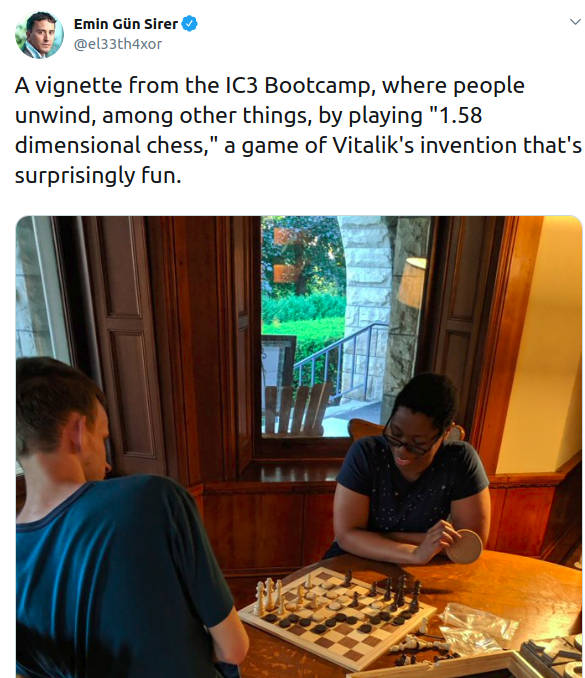
This is a variant of chess where the board is set up like this:

The board is still a normal 8x8 board, but there are only 27 open
squares. The other 37 squares should be covered up by checkers or Go
pieces or anything else to denote that they are inaccessible. The rules
are the same as chess, with a few exceptions:
- White pawns move up, black pawns move left. White pawns take going
left-and-up or right-and-up, black pawns take going left-and-down or
left-and-up. White pawns promote upon reaching the top, black pawns
promote upon reaching the left.
- No en passant, castling, or two-step-forward pawn jumps.
- Chess pieces cannot move onto or through the 37 covered
squares. Knights cannot move onto the 37 covered squares, but don't care
what they move "through".
The game is called 1.58 dimensional chess because the 27 open squares
are chosen according to a pattern based on the Sierpinski
triangle. You start off with a single open square, and then every
time you double the width, you take the shape at the end of the previous
step, and copy it to the top left, top right and bottom left corners,
but leave the bottom right corner inaccessible. Whereas in a
one-dimensional structure, doubling the width increases the space by 2x,
and in a two-dimensional structure, doubling the width increases the
space by 4x (4 = 22), and in a three-dimensional structure,
doubling the width increases the space by 8x (8 = 23), here
doubling the width increases the space by 3x (3 = 21.58496),
hence "1.58 dimensional" (see Hausdorff
dimension for details).
The game is substantially simpler and more "tractable" than full-on
chess, and it's an interesting exercise in showing how in lower-dimensional
spaces defense becomes much easier than offense. Note that the
relative value of different pieces may change here, and new kinds of
endings become possible (eg. you can checkmate with just a bishop).
3 dimensional tic tac toe
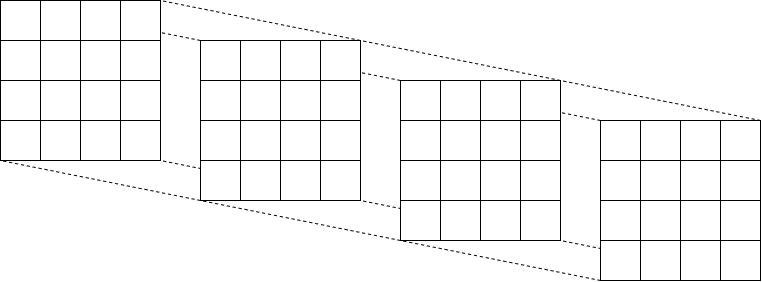
The goal here is to get 4 in a straight line, where the line can go
in any direction, along an axis or diagonal, including between planes.
For example in this configuration X wins:
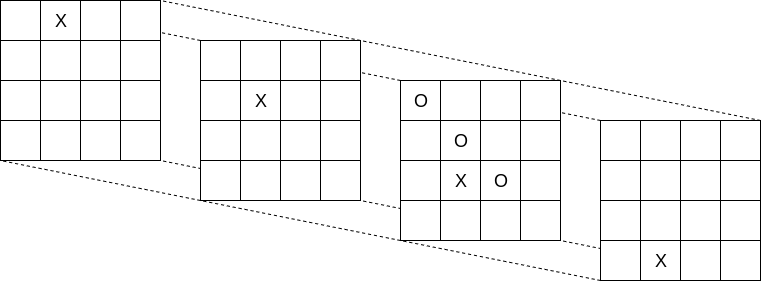
It's considerably harder than traditional
2D tic tac toe, and hopefully much more fun!
Modular tic-tac-toe
Here, we go back down to having two dimensions, except we allow lines
to wrap around:
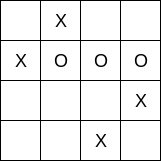
X wins
Note that we allow diagonal lines with any slope, as long as they
pass through all four points. Particularly, this means that lines with
slope +/- 2 and +/- 1/2 are admissible:
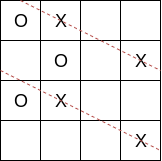
Mathematically, the board can be interpreted as a 2-dimensional
vector space over integers modulo
4, and the goal being to fill in a line that passes through four
points over this space. Note that there exists at least one line passing
through any two points.
Tic tac toe over
the 4-element binary field
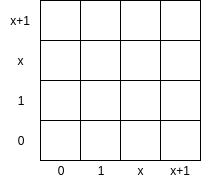
Here, we have the same concept as above, except we use an even
spookier mathematical structure, the 4-element
field of polynomials over \(Z_2\)
modulo \(x^2 + x + 1\). This structure
has pretty much no reasonable geometric interpretation, so I'll just
give you the addition and multiplication tables:
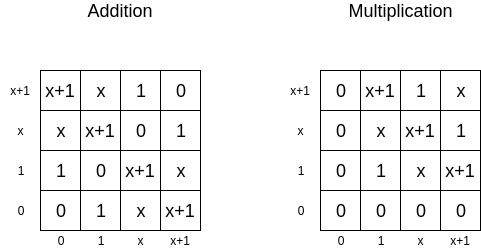
OK fine, here are all possible lines, excluding the horizontal and
the vertical lines (which are also admissible) for brevity:
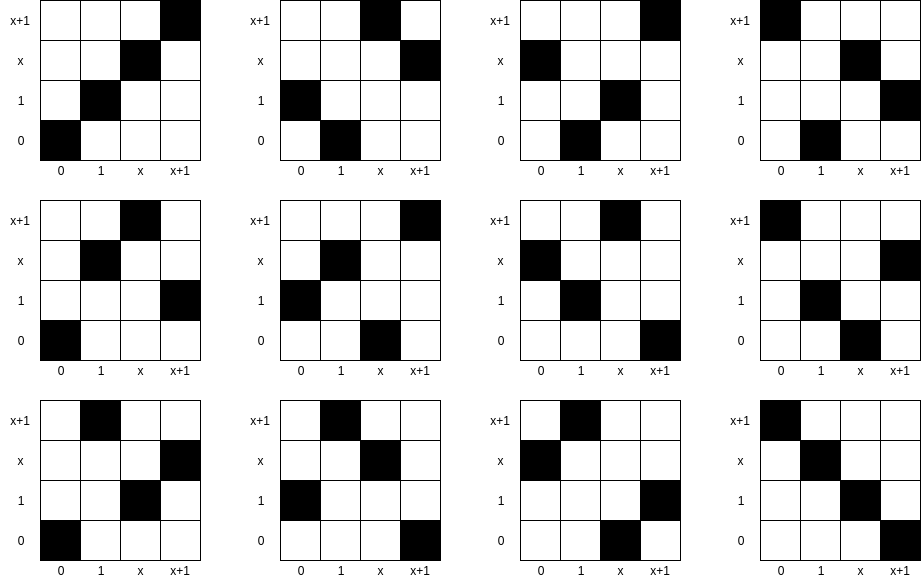
The lack of geometric interpretation does make the game harder to
play; you pretty much have to memorize the twenty winning combinations,
though note that they are basically rotations and reflections
of the same four basic shapes (axial line, diagonal line, diagonal line
starting in the middle, that weird thing that doesn't look like a
line).
Now play
1.77 dimensional connect four. I dare you.
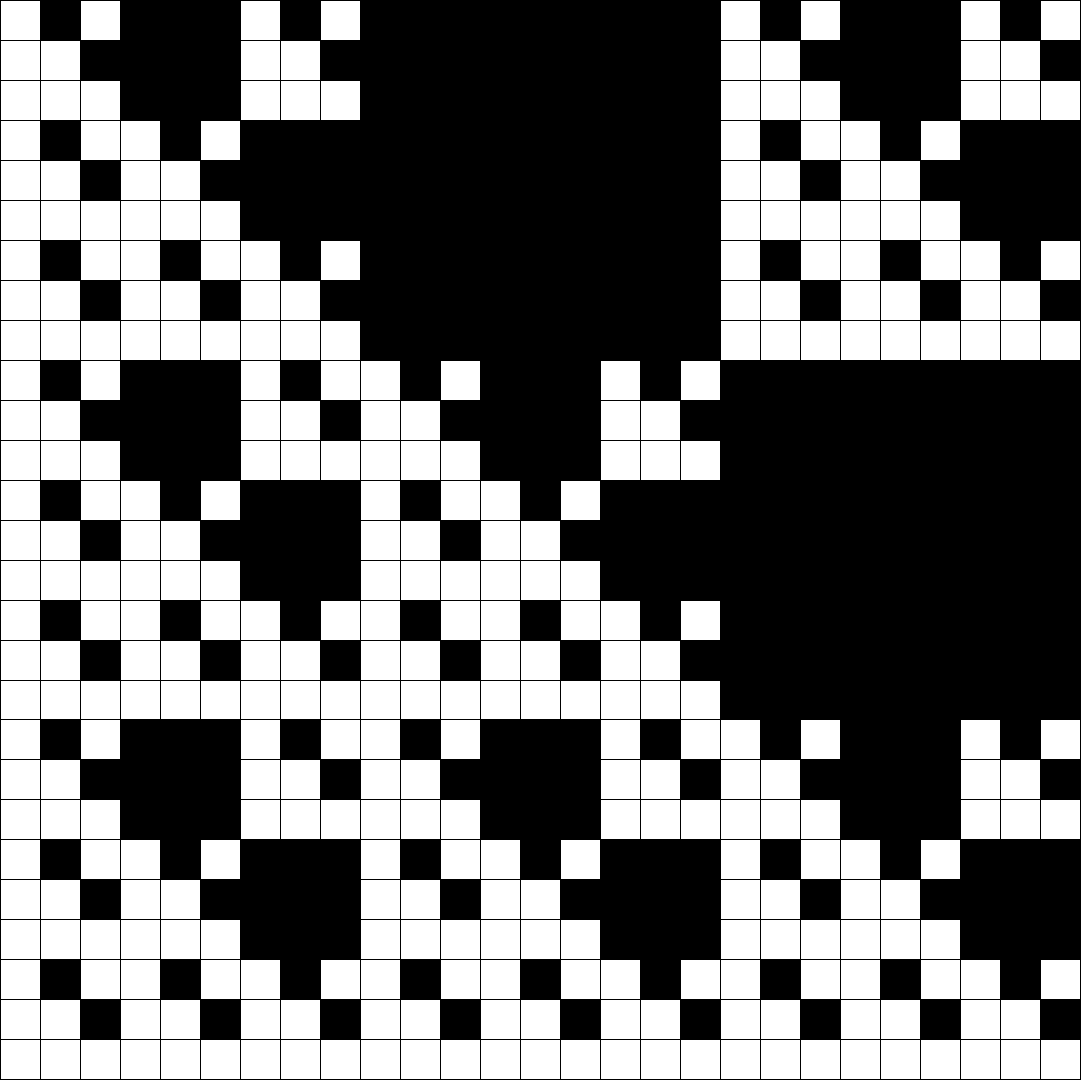
Modular poker
Everyone is dealt five (you can use whatever variant poker rules you
want here in terms of how these cards are dealt and whether or not
players have the right to swap cards out). The cards are interpreted as:
jack = 11, queen = 12, king = 0, ace = 1. A hand is stronger than
another hand, if it contains a longer sequence, with any constant
difference between consecutive cards (allowing wraparound), than the
other hand.
Mathametically, this can be represented as, a hand is stronger if the
player can come up with a line \(L(x) =
mx+b\) such that they have cards for the numbers \(L(0)\), \(L(1)\) ... \(L(k)\) for the highest \(k\).
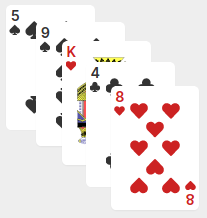
Example of a full five-card winning hand. y = 4x +
5.
To break ties between equal maximum-length sequences, count the
number of distinct length-three sequences they have; the hand with more
distinct length-three sequences wins.
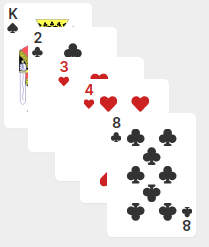
This hand has four length-three sequences: K 2 4, K 4 8, 2
3 4, 3 8 K. This is rare.
Only consider lines of length three or higher. If a hand has three or
more of the same denomination, that counts as a sequence, but if a hand
has two of the same denomination, any sequences passing through that
denomination only count as one sequence.
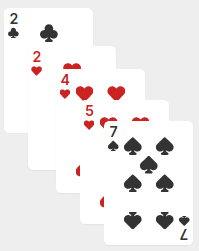
This hand has no length-three sequences.
If two hands are completely tied, the hand with the higher highest
card (using J = 11, Q = 12, K = 0, A = 1 as above) wins.
Enjoy!
Christmas Special
2019 Dec 24 See all postsSince it's Christmas time now, and we're theoretically supposed to be enjoying ourselves and spending time with our families instead of waging endless holy wars on Twitter, this blog post will offer some games that you can play with your friends that will help you have fun and at the same time understand some spooky mathematical concepts!
1.58 dimensional chess
This is a variant of chess where the board is set up like this:
The board is still a normal 8x8 board, but there are only 27 open squares. The other 37 squares should be covered up by checkers or Go pieces or anything else to denote that they are inaccessible. The rules are the same as chess, with a few exceptions:
The game is called 1.58 dimensional chess because the 27 open squares are chosen according to a pattern based on the Sierpinski triangle. You start off with a single open square, and then every time you double the width, you take the shape at the end of the previous step, and copy it to the top left, top right and bottom left corners, but leave the bottom right corner inaccessible. Whereas in a one-dimensional structure, doubling the width increases the space by 2x, and in a two-dimensional structure, doubling the width increases the space by 4x (4 = 22), and in a three-dimensional structure, doubling the width increases the space by 8x (8 = 23), here doubling the width increases the space by 3x (3 = 21.58496), hence "1.58 dimensional" (see Hausdorff dimension for details).
The game is substantially simpler and more "tractable" than full-on chess, and it's an interesting exercise in showing how in lower-dimensional spaces defense becomes much easier than offense. Note that the relative value of different pieces may change here, and new kinds of endings become possible (eg. you can checkmate with just a bishop).
3 dimensional tic tac toe
The goal here is to get 4 in a straight line, where the line can go in any direction, along an axis or diagonal, including between planes. For example in this configuration X wins:
It's considerably harder than traditional 2D tic tac toe, and hopefully much more fun!
Modular tic-tac-toe
Here, we go back down to having two dimensions, except we allow lines to wrap around:
X wins
Note that we allow diagonal lines with any slope, as long as they pass through all four points. Particularly, this means that lines with slope +/- 2 and +/- 1/2 are admissible:
Mathematically, the board can be interpreted as a 2-dimensional vector space over integers modulo 4, and the goal being to fill in a line that passes through four points over this space. Note that there exists at least one line passing through any two points.
Tic tac toe over the 4-element binary field
Here, we have the same concept as above, except we use an even spookier mathematical structure, the 4-element field of polynomials over \(Z_2\) modulo \(x^2 + x + 1\). This structure has pretty much no reasonable geometric interpretation, so I'll just give you the addition and multiplication tables:
OK fine, here are all possible lines, excluding the horizontal and the vertical lines (which are also admissible) for brevity:
The lack of geometric interpretation does make the game harder to play; you pretty much have to memorize the twenty winning combinations, though note that they are basically rotations and reflections of the same four basic shapes (axial line, diagonal line, diagonal line starting in the middle, that weird thing that doesn't look like a line).
Now play 1.77 dimensional connect four. I dare you.
Modular poker
Everyone is dealt five (you can use whatever variant poker rules you want here in terms of how these cards are dealt and whether or not players have the right to swap cards out). The cards are interpreted as: jack = 11, queen = 12, king = 0, ace = 1. A hand is stronger than another hand, if it contains a longer sequence, with any constant difference between consecutive cards (allowing wraparound), than the other hand.
Mathametically, this can be represented as, a hand is stronger if the player can come up with a line \(L(x) = mx+b\) such that they have cards for the numbers \(L(0)\), \(L(1)\) ... \(L(k)\) for the highest \(k\).
Example of a full five-card winning hand. y = 4x + 5.
To break ties between equal maximum-length sequences, count the number of distinct length-three sequences they have; the hand with more distinct length-three sequences wins.
This hand has four length-three sequences: K 2 4, K 4 8, 2 3 4, 3 8 K. This is rare.
Only consider lines of length three or higher. If a hand has three or more of the same denomination, that counts as a sequence, but if a hand has two of the same denomination, any sequences passing through that denomination only count as one sequence.
This hand has no length-three sequences.
If two hands are completely tied, the hand with the higher highest card (using J = 11, Q = 12, K = 0, A = 1 as above) wins.
Enjoy!